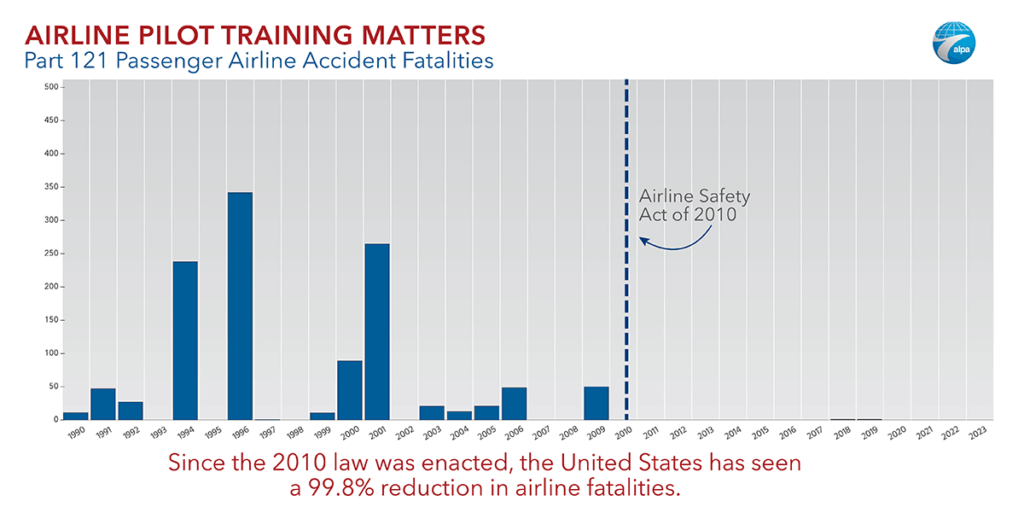When it comes to aviation safety, how you train and what you train on matters. After training, pilots spend approximately 18 months flying small, slow, single-engine aircraft (in clear weather) to build required time. No training takes place during this gap. By the time pilots accumulate enough flight time for hire, skills relevant to commercial flying have faded. Airlines repair the gap with remedial training, but still see higher failure rates. It’s time to bridge the gap with a more sophisticated solution.
In 2010, Congress passed the Airline Safety Act (Public Law 111-216). Among other things, this law requires pilots to hold an airline transport pilot certificate (ATP) and its prerequisite 1,500-flight hours to be hired as a First Officer. This change required pilots to gain vastly more pre-hire flight time, without providing financial support for pilots shouldering the burden or measures to ensure the relevance of accumulated flight time. However, the law specifically directs the FAA to provide credit for pilot academic training courses toward some flight hours when the Agency determines this training will enhance safety more than flight hours alone.
 When it comes to aviation safety, how you train and what you train on matters. For years, RAA has been raising the alarm that the 1,500-flight hour requirement is not having the intended effect of improving pilot qualifications. Today, pilots train on commercial procedures, then are sidelined to build flight hours for more than a year. While building these flight hours, they don’t encounter icing, thunderstorms, stalls/upset recoveries, or myriad other procedures needed for commercial flying. By the time they qualify, they’re out of practice.
When it comes to aviation safety, how you train and what you train on matters. For years, RAA has been raising the alarm that the 1,500-flight hour requirement is not having the intended effect of improving pilot qualifications. Today, pilots train on commercial procedures, then are sidelined to build flight hours for more than a year. While building these flight hours, they don’t encounter icing, thunderstorms, stalls/upset recoveries, or myriad other procedures needed for commercial flying. By the time they qualify, they’re out of practice.
The same studies FAA used to craft the rule have been updated several times. Each study shows that pilots gain flight time at the expense of the quality and recency of their training. Overall, pilots today perform worse in airline training compared with before the rule. However, pilots from structured training pathways have better training performance than pilots from hours-based pathways.
Unfortunately, just one-third of pilots qualify through structured training pathways today, despite their proven safety advantage. The FAA approved just three structured training pathways in 2013, with no updates since. Airlines support more structured training pathways, but FAA must act. Safety means following the data. It’s time to move forward.
For years, ALPA has been using this chart to show a purported link between airline fatality reductions and a law passed in 2010 (but implemented years later). It’s simply not true.

ALPA is waging a cynical war against the facts — mischaracterizing proposals, distorting statistics and even blocking important safety advancements in pilot training. Why? Because the same advancements that improve safety also make the career path more accessible, while some hope that a large moat around the career will preserve a pilot shortage and drive wages higher.
Pilots deserve to be, and are, well-compensated. Entry level wages at regional carriers average more than $100,000 per year and senior pilots at large airlines can make $590,000 per year. It’s time to call for an end to manipulative scare tactics.
RAA has never sought to weaken aviation safety and has never proposed to remove a single hour of aviation training. Instead, we have consistently called for improvements to pilot qualifications, because the current standard permits the accumulation of simple flight hours, including time in simple aircraft or even hot air balloons, that do nothing to improve pilot skills and instead lengthen the time between a pilot’s training completion and eligibility for hire, a period where skills are lost today.
– AIRLINE PILOTS ASSOCIATION
– AIRLINE PILOTS ASSOCIATION
– AIRLINE PILOTS ASSOCIATION
FAA confirms that 35 major airports have received Airport Surface Detection System — Model X (ASDE-X) which “…is a surveillance system using radar, multilateration and satellite technology that allows air traffic controllers to track surface movement of aircraft and vehicles.” [See: https://www.faa.gov/air_traffic/technology/asde-x.]
FAA reports that 46 U.S. operators have FAA-approved FOQA programs. FOQA, which started in the 1990’s with four U.S. operators, “…collects and analyzes digital flight data generated during normal operations.” FAA states, “[t]he information and insights provided by FOQA can improve safety by significantly enhancing training effectiveness, operational procedures, maintenance and engineering procedures, and air traffic control procedures.” [See: https://www.faa.gov/newsroom/aviation-voluntary-reporting-programs-1.]
FAA issues the final rule for the Pilot Records Database which “…requires air carriers and certain other operators to report pilots’ employment history, training, and qualifications to the database. The rule also requires air carriers and certain operators to review records contained in the database when considering pilots for employment.” [See: https://www.faa.gov/newsroom/faa-completes-rule-establishing-pilot-records-database-increase-safety.]
ASIAS participation grows to include “…data from 41 airlines, which according to FAA represents 99 percent of air carrier operations.” [See: https://www.oig.dot.gov/sites/default/files/FAA%20ASIAS%20Final%20Report%20-%2003.10.2021.pdf.]
Unlike ALPA, we still stand by our statements. We deserve a stronger, smarter, more sophisticated solution to safety.
Address
1201 15TH STREET NW,
SUITE 430
WASHINGTON, DC 20005
Navigate
Connect